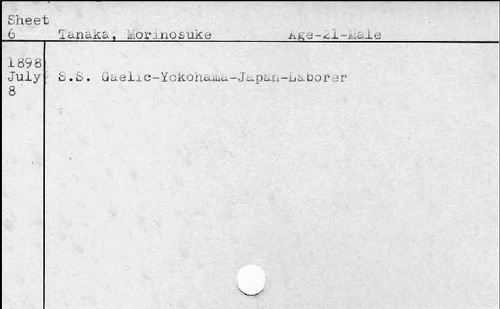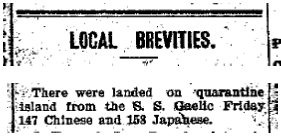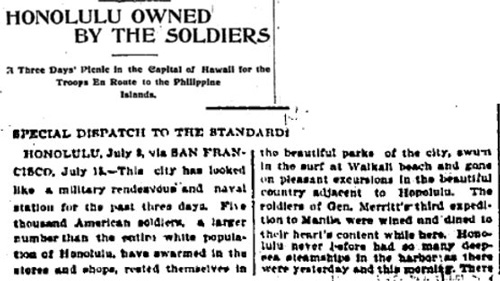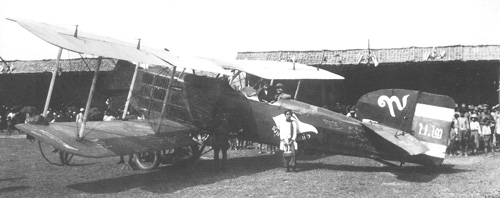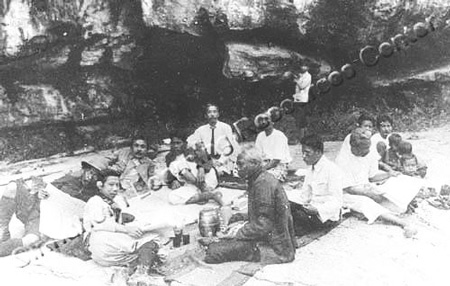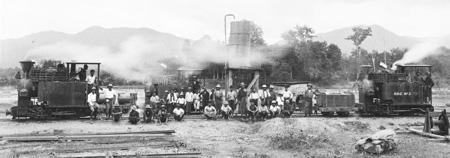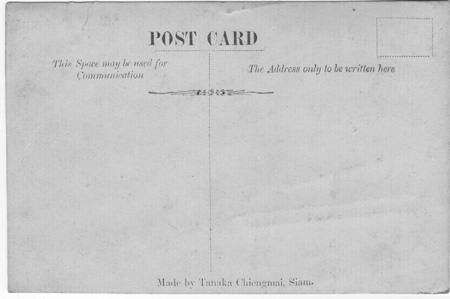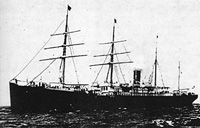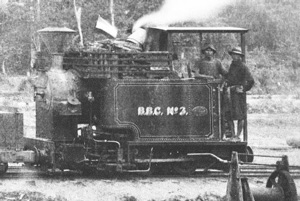Japan in Northwest Thailand during World War II
| N18°47.235 E99°00.320[1] | Morinosuke Tanaka (Th: ทานาคา / Jp: 田中盛之助[1a] ) page 1 of 2 |
Route 0106 |
| Text | Notes | ||
|
Tanaka's "real" role in Thailand has long been a subject of speculation amongst English-speaking history buffs in Chiang Mai. However Tanaka's function in Thailand turns out to have been fairly well documented in his own home country more than twenty years ago in a series of articles in the Asahi Shimbum. The series was the result of efforts by one of its investigative reporters, Itsuya Matsumoto; and he subsequently combined his columns and expanded on them in his Japanese Photographers in Siam, published in 1992 (in Japanese).[4] In it, Matsumoto recounted his process of discovery step-by-step, working through extensive interviews with two people who knew Tanaka, and supplementing those with recollections of others plus some basic records research; his quest carried him from Kagoshima and Yokosuka in Japan, to Bangkok and Chiang Mai in Thailand. In turn, Matsumoto used, as a guide, a "booklet" by Shu Hatano, Tanaka's son-in-law, written more than 15 years before his investigation: Memories of Living in Thailand for Sixty Years (also in Japanese),[4a] which was apparently also quite revealing. Matsumoto's detail offered an interesting insight into the travails of an investigative reporter as well as some clarification of Tanaka's activities in Thailand; but both his process and its results were hidden from Westerners by the barrier of written Japanese. With the assistance of the Google Translate machine, coupled with the checking of critical items with a knowledgeable Japanese-English translator,[5] a more meaningful picture of Morinosuke Tanaka can now be constructed. What follows is a chronological consolidation of facts about Tanaka, which admittedly relies heavily on Matsumoto's work. However, it is supplemented with relevant concurrent information from various sources, plus some hopefully plausible speculation to fill in gaps. 1875-1896: Morinosuke Tanaka was born on 23 August 1875 in Kagoshima,[6] on the most southerly of Japan's four main islands, Kyushu. His birth came only 21 years after US Admiral Matthew Perry, with his ominous "Black Ships", forced Japan to sign the Convention of Kanagawa. That agreement eventually led in 1868 to the beginning of the Meiji Era which was characterized by a huge national effort to modernize Japan. But the era did not start smoothly: Kagoshima, then known as Satsuma, was an independent minded province, and did not willingly accede to the new Meiji government. In 1877, in the Satsuma Rebellion, the province unsuccessfully revolted against Tokyo. Tanaka's father, as a minor samurai in the Satsuma Clan, participated in that revolt.[6a] For his actions, the father was imprisoned for three years in Tokyo. He was then released with seemingly no prejudice, possibly because he was a lower level samurai.[7] Morinosuke was heir to this tradition of independent thinking.[7a] His father established a photo shop in Tenmonkan City[8] in Kagoshima Prefecture and by 1893, if not before, Tanaka (aged 18) was working there.[8a] Thus he early developed a familiarity with many aspects of photography.[8b] Early in 1896: Tanaka at this time was portrayed as "young and eager for adventure": he had probably been swept up by the momentum of new ideas accompanying the Meiji Era. He announced to his family that he wanted to go to Formosa (Taiwan) to study photography.[9] What Formosa offered that his work in Kagoshima had not already provided was not explained. Formosa had only recently been occupied by Japan per the 1895 Treaty of Shimonoseki which settled the First Sino-Japanese War. Formosa was viewed as largely rural, with an agrarian economy focused on growing sugar and tea.[9a] It did not appear to his family to be an ideal place to study photography, with Shanghai[9a1] being generally favored for gaining experience in that field.[9b] Despite entreaties from his family, he persisted, and with the support, both in spirit and financially, of a well placed "friend", Kyukai Arikawa (有川九介),[9c] Tanaka departed, ostensibly for Formosa. 1896-1902:[10]
Tanaka's life, up to his departure for Formosa, is reasonably well documented by Matsumoto, based on family interviews. In contrast, for the period after Tanaka's departure until he arrived in Bangkok, there was only Tanaka himself for a source. As implied above, family members interviewed by Matsumoto had been skeptical about his claimed interest in studying photography in Formosa,[10a] and a letter from him during his time in Formosa indicated that he had become involved in something else.[10b] Matsumoto concurred in the family's skepticism, and pointed out that Tanaka had never offered any but the sketchiest of detail about his time in Formosa or in Xiamen.[11] Boonserm Satrabhaya, another source, was also extremely vague about that period.[11a] There is a possibility that Tanaka never went to Formosa (see below). Tanaka's comments about this period seem to have disclosed only:[11b] 1896: He departed for Formosa to study photography. These facts were recorded in a newspaper interview in 1907.[11c] Subsequently, two events from that period, which Tanaka apparently never intended for public disclosure, surfaced: Before he arrived in Siam, he had worked in the (Japanese) Army Chiefs of Staff map department (more properly the Land Survey Department of the General Staff Headquarters).[11d] He divulged this to his (future) son-in-law, Shu Hatano, sometime after Shu started working with him in 1930 in Tanaka's Chiang Mai photo shop. A US Immigration document records that a Morinosuke Tanaka disembarked in Honolulu in 1898.[11e] While the surname, Tanaka, is very common in Japan,[11f] the given name, Morinosuke, is definitely not. Hence it is plausible that this was the same individual that is the subject here. In addition, the date of arrival fits nicely into a period otherwise vaguely defined for Tanaka. The conclusion to draw here is that Tanaka's failure to provide details about this period was intentional. And that intentionality, coupled with the two rich insights above about his activities during that period, begs for speculation. Note that without this information, Tanaka might today carry only the reputation he apparently intended. Later in 1896: So, Tanaka perhaps went first to Formosa. While Formosa was judged perhaps primitive because of its economy based on sugar and tea, China had seen it as an important link in its defense network and had invested heavily in its infrastructure development as well as its defense facilities.[12a] Most notable was the installation of modern Armstrong breechloader guns at various coastal defense facilities on the island, but at no other location in China at that time.[12b] That buildup had been prompted in part by Japan's many efforts to take over the island starting in 1592, as a part of a policy which, in Tanaka's early life, had matured into its Southern Expansion Doctrine:[12c] Formosa was seen as a stepping stone to Southeast Asia.[12d] The strengthening of Formosa's defenses was also partly the result of the Sino-French War in 1884-1885; China had won that war, but the conflict had emphasized to China the importance of the island in its coastline defense system.[12d1] In this later conflict in 1895, the First Sino-Japanese War, which China lost, Japan had acquired Formosa as part of a settlement with China.[12e] The victory contributed to Japan's military and citizenry regarding their nation as invincible. If Tanaka did go to Formosa, he would have arrived in time to witness Japanese Army tactics in fighting a guerrilla resistance, tactics which were characterized as having "perpetrated all the worst excesses of war".[12f] Whether working in a land survey function or as a photographer, he would likely have been too late to have contributed to a series of 1:200,000 scale topographic maps of Formosa which were published in 1897 under the direction of the Japanese General Staff Headquarters.[13] More likely, he would have been part of an early effort collecting data for a new series of larger scale topos of Formosa, whose publication started in 1913. 1898: Tanaka then went to Hawaii where Japan had special concerns: Contract labor: After the early failure of an 1868 effort to import Japanese labor to work its sugar cane fields, the Kingdom of Hawaii had restarted importing Japanese labor based on an understanding which was formalized in 1886.[14] By 1894, 29,000 Japanese Nationals were present in Hawaii (growing to 61,000 by 1900).[14å] Their mistreatment by US commercial sugar companies was appalling, judged by even the standards of the period,[14a] and this became known to the Japanese government. With the overthrow of the Kingdom in 1893 by a cabal of US sugar interests, the position of those workers became more uncertain and raised deep concern in Japan.[14b] That concern could have resulted in Tanaka being assigned to provide an on-the-ground assessment of the situation. Strategic interests: The US Navy's evolving theory of sea power had alerted Japan to the strategic significance of Hawaii in the Pacific in 1890.[15] The overthrow of the Kingdom government in 1893, followed by commercial interests lobbying the US Congress to annex the islands[16] roused Japanese concern, and Hawaii became a major focus of the Japanese government.[17] Tanaka's arrival in Honolulu in 1898 could be interpreted as having been some part of that focus. Curiously, two days before Tanaka landed in Honolulu, the US formally annexed Hawaii.[18] So, in 1898, a secretive Tanaka boarded the SS Gaelic[18å] bound for Honolulu, to all appearances a "Dekasegi" (出稼ぎ), a common laborer: ". . . a Japanese worker who plans to return to [his] homeland after making money in a foreign land . . .". An example of agricultural work: "Sugar plantations in Hawaii (3 year contract)".[18a] He arrived in Honolulu to be recorded as passing through US Immigration on 08 July 1898 as a laborer per this file card:[18α]
While Tanaka was actually age 22 on this date, the 21 on the file card might reflect a confusion about East Asian age reckoning where a person's age at birth was assumed to be one; in contrast, the Western system assigns an age of zero at birth. Possibly an immigration officer mistakenly tried to correct Tanaka's stated age --- which Tanaka had already corrected to the Western standard. Another possible source of confusion might have been trying to convert Tanaka's birth date from the Meiji calendar to the Gregorian calendar, that transition having occurred in 1873, two years before Tanaka's birth.[18b] "Yokohama" appears on the card because it was the port-of-call previous to Honolulu. What the itinerary of the SS Gaelic was has not been found; but the ship is recorded as having been in Nagasaki in 1898,[18c] so where Tanaka had actually boarded the ship is uncertain. On 12 July 1898, the Hawaiian Gazette recorded that 158 Japanese from the SS Gaelic were on Quarantine Island:[18d]
From Quarantine Island, they could view the town of Honolulu, across a kilometer-wide dredged ship channel. Concurrently, Honolulu was being inundated by US Navy personnel on their way to secure the Philippines after Dewey's lopsided victory in the Battle of Manila Bay, a part of the Spanish-American War. This new American foothold in Southeast Asia could only have bonded Japan more firmly to its Southern Expansion Doctrine:[18e]
There is no information regarding Tanaka's activities in Hawaii. Japanese army maps of Hawaii offer no clue: those available in Japanese archives were published by the Ordnance Survey Department of the Japanese Chiefs of Staff in 1942 (after the attack on Pearl Harbor). They were based on US State Department topographic maps issued between 1911 and 1930,[18f] which were, "as is", quite adequate in detail. Japanese map makers' primarily contribution appears to have been providing map legends in Japanese.[18g] Tanaka's objective was probably unrelated to mapmaking, but rather, as suggested above, to observation and reporting on working and living conditions of Japanese laborers employed on the Islands after the overthrow of the Kingdom of Hawaii in 1893, or something to do with an assessment of US military preparedness. It is even possible that he "escaped" from the island and traveled to the US Mainland to evaluate how that connection functioned.[18g1] 1901: On the assumption that Tanaka's time in Hawaii was based on a three year Dekasegi contract, and he and his employer complied with it,[18h] he would have departed Hawaii in July 1901.[18h1] He indicated to the Kagoshima press that in that year he moved on to Xiamen.[18i] It was a Chinese "treaty port" opened in 1842 by the Treaty of Nanking which had resolved the First Opium War between Britain and China. An island in the delta of the Jiulong River, it provided access to the Chinese mainland and was only 225 km west of Formosa.[18j] As an international trans-shipping point, it would have had a far more sophisticated populace than Formosa, with technology likely available for expanding Tanaka's photographic skills. But, as in Formosa, the Japanese there were enduring a substantial hostility from Chinese inhabitants.[18j1] Perhaps they anticipated, correctly, that Japan saw Xiamen as important to its Southern Expansion Doctrine,[18k] and would eventually occupy it, which it did in 1938.[18l] What Tanaka did in Xiamen is unrecorded. 1902: Tanaka left Xiamen and arrived in Bangkok.[19] An alternate, more benign, explanation for Tanaka's actions from 1896 through to 1902 might be that he was just looking for a new place to start a business; this could be supported by Wikipedia's article about the IJA's secret police, the Kempeitai:[20] In the period from about 1895 to 1941, Japan encouraged emigration of its citizens to nations bordering the Pacific Ocean . . . The position taken by Tokyo was that [they] held dual citizenship, with loyalty to Japan, and loyalty to the Emperor first and foremost. 1902-1929: Tanaka began a twenty-seven year period in which he apparently worked very successfully as a photographer in Thailand, as evidenced by the numerous "Tanaka" photos in various collections around Chiang Mai.[21] 1903: In Bangkok, Tanaka apprenticed himself to Robert Lenz, an accomplished photographer from Germany,[22] who operated a photo shop and amongst his clientele numbered royalty from all over Thailand, starting right at the top with King Chulalongkorn.[22a] Some of Lenz's photos are still marketed today:[22b]
Tanaka, demonstrating a notable savoir faire, fit right in and seemed to have befriended the cream of Thai society.[22c] 1904: While Tanaka was in Bangkok, the Russo-Japanese War began on 08 February, nominally over control of Manchuria and Korea. Japan wanted Russian recognition of its control over northern Korea, while Russia wanted to retain control of Port Arthur, its only warm water port on the Pacific (and the railway to it).[22d] 1905: The Russo-Japanese War ended 05 September with the Treaty of Portsmouth. "The complete victory of the Japanese military surprised world observers."[23] Japanese military and citizens continued to be lulled towards a sense of invincibility. Apparently unaffected by the war, Tanaka left Lenz and joined a fellow Japanese, Kaishu Isonaga, in operating Isonaga's photo shop in Bangkok which had started in business in 1895. Their working together is evidenced in this photo mount dated 20 November 1905:[24]
and[24a]
Note that while Isonaga was the senior of Tanaka by 15 years in a society which venerated age, Tanaka's name came first in the upper extract and above Isonaga's in the lower extract. The reason for this is not clear. 1907: Tanaka returned to Kagoshima, Japan to visit his family, and his return was covered by a local newspaper. His time in Kagoshima seems to have been notable primarily for his having spent so little time there:[24b] he was said to have been busy in Tokyo purchasing photo supplies for himself, plus music and movie film for Thai friends. While in Tokyo, he became ill with empyema, went to hospital where he recovered, and, in the process, had an affair with a nurse, which resulted in a child. The couple were married in June. Tanaka however was seen by his family as concentrating on collecting supplies for his shop in Siam, and then leaving for Siam in December. His son was born a month after he left, in January 1908; Tanaka never returned to Japan and never saw the child.[25] A necessary digression: It would be unfair here to leave Tanaka with an appearance of raw heartlessness for his actions in this situation: his actions could evidence an individual responding to a higher clingstone religious, but rather patriotic. If so, it could imply that Tanaka did have an assignment, a lifetime assignment, representing the interests of his country overseas. Tanaka did make arrangements for the son to be raised in his parents' household and his father extended that arrangement to include his daughter-in-law.[25a] Tanaka did keep in touch with his Japanese wife and son, and regularly transferred money to them.[25b] He is said to have gotten the boy a job in a trading company in Tokyo, where he worked in the "Thailand Room".[25c] A niece of Tanaka later noted that the son had been trying to get transferred to a position in Thailand,[25d] when he had been killed in a freak railway accident in 1954.[25e] On receiving news of his son's death, Tanaka was said to have been badly shaken.[25f] 1909: After six years in Bangkok and befriending visiting royals from around Siam, Tanaka left Kaishu Isonaga to accept an invitation from the Prince of Lampang to open a photo studio in his province, which was prospering with its teak harvesting industry.[26] Rail connections to the far north of Siam were still under construction, so Tanaka went as far as Nakhon Sawan by rail; from there he continued by boat on the Chao Phraya and then the Wang River to Lampang.[26a] 1910: Tanaka's former partner, Kaishu Isonaga, wanting to travel, turned his photo shop in Bangkok over to a Shozo Hatano, and left. Hatano had worked there since perhaps 1905, and therefore knew Tanaka, who had left in 1909.[26b] Curiously, with Tanaka gone in 1909 and Isonaga in 1910, the two would still be listed as principals in "K Isonaga Photographers" in The Siam Directory 1912.[26b1] 1911: After working in Lampang for two years as the sole photographer there,[26c] Tanaka was invited to set up shop in Chiang Mai by a Dr Edwin Cort from that town;[26d] he accepted, lured by a larger customer base and a prosperity greater than in Lampang.[27] The Northern Rail Line, still under construction, again proved a hindrance to his travels, so Tanaka walked to Chiang Mai, with his equipment trailing him, carried on horseback.[28] He set up shop in the Wat Gate area of Chiang Mai, with the river to his back;[29] exploring entrepreneurship, he also set up the first cinema in Chiang Mai on Wichayanon Road near the present day President Hotel. His photographic enterprise flourished, and he became affectionately known as "Naiharn Tanaka", ie, owner of the Tanaka photo shop.[29a] The cinema eventually failed with the opening of the Tantawan Theater at the Chang Klan-Loi Kroi intersection.[30] Tanaka was an avid sportsman, proficient in tennis and golf.[30a] His skills, coupled with his naturally gregarious nature, enabled him to indulge in those sports as a guest at Chiang Mai's Gymkhana Club. His participation was sufficiently frequent that some in the surrounding community assumed that he was an ordinary member.[30b] Club rules however excluded him since he was not of British, European, nor American nationality (ie, Caucasian).[30c] That limitation also apparently precluded him from participation in the various inter-club competitions, from mention in the club minutes, or official photos (though he probably took them).[30d] 1914: Tanaka married Changdee Ping'yo, who lived in Lamphun.[31] Shu Hatano, who would become Tanaka's son-in-law 25 years later, volunteered an insight about foreigners who married Thais: Siamese nationality was required to own land in Siam (a requirement which continues today) and it was common practice for foreign males, including Japanese, to marry Thai women so as to be able to hold land. Hatano himself may have used the same ploy, however Matsumoto's wording on this tack is ambiguous, and probably tactful:[32] this same Shu Hatano was Matsumoto's primary information source in Thailand 75 years later. Subsequently, Tanaka acquired control of land adjacent to the First Church of Christ on which he built a permanent two storey house and shop:[33]
Behind the house, Tanaka built a photo studio with a north facing skylight to catch light from the northern sky. Such light is still favored today by purist portrait photographers.[33a] However, in Tanaka's early days in Chiang Mai, the skylight was not a luxury, but rather a necessity: there was no mains power available in Chiang Mai.[33b]
A son was stillborn to the couple.[34] Shozo's brother, Shu Hatano, 16 years younger, and Tanaka's future son-in-law, left Japan and joined Shozo at his invitation to work in the photo shop in Bangkok given to him by Kaishu Isonaga.[34a] 1915: On 20 August, a daughter was born to the Tanaka couple. She was named Cheiko in Japanese and Kumpoon in Thai.[35] 1917: Tanaka and Changdee divorced. The daughter stayed with Tanaka.[36] Changdee returned to Lamphun and later married a Thai.[36a] 1918: Apparently hired by the Bombay Burmah Trading Company (BBTC) to photograph a company logging facility around Mong Hang, Burma (~N20°03.6 E98°56.3), Tanaka recorded an unnavigable underground river passing through a grotto named Gnoke (N20°09.7 E98°54.1), with an elaborate 12 km land route workaround ending in a chute dropping about 300 m into the Hang River.[36b] 1921: A Japanese botanist doing field work in Southeast Asia, Soda Bunzo (早田文蔵), was recorded as having been hosted by Tanaka during his stay in northern Thailand.[37] Bunzo would have been enjoying the support of an informal but active network that linked Japanese expatriates everywhere (all nationalities of any significant number could rely on such networks for support in foreign countries). 1923: Tanaka recorded the arrival of the first aircraft in Chiang Mai:[38]
1927: Tanaka, in white shirt and dark tie, was pictured on a holiday outing with various government officials and their friends and families at "Pha Ngeub" on Doi Suthep:[38a]
Around 1927, Tanaka was apparently commissioned by BBTC to photograph the company's transport activities in its Li-Soem Logging Concession. His work included one of his more famous photos, that of railroad crews and equipment in BBTC's Li-Soem railroad yard:[38b]
During this period, Tanaka capitalized on his photographic efforts, marketing some of his photos as postcards:[38c]
|
This page is best viewed with Google Chrome. See Key for interpreting page content. Revision list. See bottom of Text column on this page. Bibliography generally supports notes. Joyce Ann Aurino corrected references in Notes 3a and 4a [added 16, 18 Jul 2016] and provided detail for Note 4a [17 Sep 2016]. 1.^ Google Earth fix on insurance building currently at site originally occupied by Tanaka's Photoshop. 1a.^ Tanaka was not known by his given name in Thai. Tanaka was pronounced with emphasis on the first syllable, TA-na-ka. 2.^ Stationing measured from center intersection Rte 106 and Charoen Muang Rd (assumed zero point for Rte 106 stationing). 3.^ Extract from photo (see below). 3å.^ เอนก นาวิกมูลฺ ประวัติการถ่ายรูป ยคแรกของไทย กรุงเทพฯ [Anake Nawigamune, History Of Early Photography In Thailand, (Bangkok: White Lotus, 2005) (Thai Text)], pp 187, 188. Hereafter, Anake. 3a.^ 松本逸也, シャムの日本人写真師 (東京: めこん, 1992) [Itsuya Matsumoto, Japanese Photographers in Siam (Tokyo: Mekong Publishing Co, Ltd, 1992) [hereafter Matsumoto], p 14. The plural "photographers" in the title, Japanese Photographers in Siam, refers to four photographers, one of which is Tanaka. The other three are his son-in-law, Shu Hatano, and Shu's brother, Shozo, plus a predecessor and early contemporary, Kaishu Isonaga. 3b.^ The most recent being Boonserm Satrabhaya, Chiang Mai in Memories (Chiang Mai: Chao, 2011), with text in Thai, Japanese, and English. (hereafter Boonserm). 3c.^ Matsumoto, p 85. 4.^ Matsumoto. 4a.^ 波多野秀, タイ国在住六十年想い出すままに (チェンマイ: 自己出版、昭和四十九年) [Hatano, Shu, Memories of Living in Thailand for Sixty Years (Chiang Mai: privately printed, 1974)]. A copy is archived at the Japan-Thailand Association in Tokyo as listed in its Holdings, entry 13. No copy has been found in Thailand. From the Probus Club newsletter no. 233 of 09 Apr 2015, pp 4-5 (Japanese text): Koji Hashimoto wrote of being sent as a specialist to Chiang Mai by the Japan International Cooperation Agency (JICA) in 1974. There he became friends with Hatano. With Hashimoto's encouragement, Hatano wrote of his experiences in Thailand. Natsuko Hozumi made a mimeograph master of Hatano's original text. The memoire as finally published had no colophon (implying a private printing) and was of poor quality (consistent with mimeographing). 5.^ Joshua Skiles. 6.^ His cemetery marker at Wat Tha Satoi in Chiang Mai reads 1873, which is in error. (Matsumoto, pp 89, 118, 229). 6a.^ Matsumoto, p 100. In the Satsuma Clan, the tradition of independence was very strong: in 1865, defying a Tokyo edict to maintain the nation's isolation, the Satsuma clan smuggled 15 sons to the UK to learn Western ways (Wikipedia: Nagasawa Kanaye) (this might have been a model for sending five girls to the UK in 1871, as described in Barbara Chai's Daughters of the Samurai). In 1877, Saigo Takamori, the leader of the clan and, as "the last true samurai", faithful to the code of the samurai, died in the same rebellion that put Morinosuke's father in prison. 7.^ Matsumoto, pp 119, 120. 7a.^ Matsumoto, however, repeatedly suggests a Tanaka hardened by Japan's sense of imperialism (p 85 (typical)), and male chauvinism (p 87 (typical)). 8.^ Matsumoto, p 78. Boonserm, pp 50-52. 8a.^ Boonserm, p 53. 8b.^ Boonserm, pp 50-52. 9.^ Matsumoto, p 120. 9a.^ Matsumoto, p 191. 9a1.^ However, the Sino-Japanese War had just ended; Chinese animosity directed towards Japanese was at a high and forced another Japanese photographer, Kaishu Isonaga, out of business in Shanghai and to relocate to Bangkok, where Tanaka met him in 1903 (Matsumoto, p 24). 9b.^ Matsumoto, pp 40ff, 121. 9c.^ Matsumoto, p 120. 10.^ This period in Tanaka's life is covered here in greater detail because the detail was not known when Matsumoto and Boonserm published. 10å.^ Google Earth view centered on N28° E150° at eye alt 8370km. Image captured with Gadwin PrintScreen, enhanced with IrfanView and annotated with Microsoft Publisher by author. Date sources: 10a.^ Matsumoto, p 121. 10b.^ Matsumoto, pp 122, 190. 11.^ Matsumoto, pp 122, 190. 11a.^ To be fair, it must be noted that Boonserm's position was that of an apprentice learning the skills of photography from a master, in this case, Hatano. Hence Boonserm would not have been motivated to critically evaluate any comments by Hatano. 11b.^ Matsumoto, pp 122, 229. 11c.^ Matsumoto, pp 190, 191. 11d.^ Matsumoto, p 25. 11e.^ See file card illustration below. 11f.^ Tanaka is the fourth most common surname in Japan (Wikipedia: List of most common surnames in Asia: Japan, accessed 12 Aug 2015). No list of given Japanese names was found on the Internet --- in English anyway. 12. (deleted) 12a.^ Wikipedia: Taiwan under Qing rule, accessed 12 Aug 2015. 12b.^ YC Chen msg of 1737 hrs 13 Oct 2015, in Axis History: Chinese military installations in Taiwan in 1895 12c.^ Wikipedia: Nanshin-ron, accessed 12 Aug 2015. 12d.^ Wikipedia: The Treaty of Shimonoseki: Taiwan, accessed 12 Aug 2015. 12d1.^ Wikipedia: Hobe Fort, accessed 12 Aug 2015. 12e.^ Wikipedia: The Treaty of Shimonoseki: Treaty terms, accessed 12 Aug 2015. 12f.^ Wikipedia: Taiwan under Japanese rule (accessed 01 Oct 2015), quoting The Cambridge Modern History of 1910. 13.^ Gaihozu Map Digital Archive, (search on "Taiwan"), items 36-49. It is not clear if the IJA actually performed a land survey for that map series, or merely updated existing Chinese maps of the area.(query to Axis History Forum, Early topo mapwork for Taiwan, produced no response). China's accelerated development of infrastructure on the island in the 1870s-1880s (see notes 12a and 12b above) would likely have been accompanied by a substantial mapping effort. 14.^ "Hawaiian-Japanese Labor Convention of 1886" (Ogawa, Dennis M, and Glen Grant, Kodomo No Tame Ni-For the Sake of the Children: The Japanese-American Experience in Hawaii (Honolulu: University of Hawaii Press, 1980), p 6ff). 14å.^ Wikipedia: Robert Walker Irwin: Kanyaku Imin, accessed 12 Aug 2015. 14a.^ Hawaii: Life in a Plantation, Library of Congress website: Japanese Immigration. 14b.^ Ogawa, ibid. 15.^ Wikipedia: Alfred Thayer Mahan: Japan, Wikipedia, accessed 12 Aug 2015. 16.^ Wikipedia: Overthrow of the Kingdom of Hawaii, accessed 12 Aug 2015. 17.^ Wikipedia, ibid, accessed 29 Aug 2011. 18.^ Wikipedia: Hawaii, Annexation, accessed 12 Aug 2015. 18å.^ Apparently this was the RMS Gaelic, of 4200 tons, chartered to the Occidental & Oriental Steamship Company:
Tanaka was lucky: a month and a half later, the ship ran aground (14 Aug 1896) at Shimonoseki and had to be towed to Nagasaki for repairs. (Wikipedia: RMS Gaelic, accessed 16 Oct 2015) 18a.^ Sanders, Maia, Temporary and Seasonal Migrants (Japanese in Pacific, accessed 12 Aug 2015). But the term also applies to Brazilians migrating to Japan for work; see Wikipedia Dekasegi, accessed 12 Aug 2015. 18α.^ US Immigration Card for Honolulu, accessed 15 Jul 2011. 18b.^ Japanese calendar (link confirmed 12 Aug 2015): Meiji era changes. As a part of its modernization effort, Japan moved from a lunar calendar to a Gregorian calendar amid much confusion. Tanaka's birth date as recorded at his memorial in Wat Tha Satoi in Chiang Mai errs the other direction recording 1873, two years before the date in the Tanaka family register (Matsumoto, pp 25, 229). 18c.^ SS 'Gaelic' at Nagasaki (link confirmed 12 Aug 2015). 18d.^ Hawaiian Gazette, 12 July 1898, p 3, Newspaperarchive.com (by subscription). With some irony, Quarantine Island, renamed Sand Island, served as an internment camp to temporarily house Japanese-Americans in the early part of World War II (Wikipedia: Sand Island (link confirmed 12 Aug 2015)). Quarantine Island no longer exists: it was "swallowed up" with the dredging that created Sand Island. 18e.^ Syracuse Semi-Weekly Standard, 19 Jul 1898, p 4, Newspaperarchive.com (by subscription).
18f.^ Gaihozu Map Digital Archive, (search on "Hawaii"), items 1-62. 18g.^ For example, see
18g1.^ Immigration-Japanese, Hawaii "Life in a Plantation society" (link confirmed 12 Aug 2015): . . . thousands fled to the mainland before their contracts were up. 18h.^ Some contract workers escaped the plantations to live in towns and others somehow traveled to the mainland; others after three years refused to return to Japan and moved into the towns (Ogawa, p 9; Hawaii: Life in a Plantation, ibid). 18h1.^ No other information from US Immigration is currently available. 18i.^ Matsumoto, p 229, specified 1901, while Boonserm, p 53, specified 1898. Matsumoto based his date on the Kagoshima newspaper article. 18j.^ Google Earth Scale tool. 18j1.^ Matsumoto, p 192. 18k.^ Wikipedia: Nanshin-ron and, by that time, the Greater East Asia Co-Prosperity Sphere (both links confirmed 12 Aug 2015). 18l.^ Wikipedia: Xiamen, link confirmed 12 Aug 2015. 19.^ Matsumoto, p 229; Boonserm, p 53, wrote 1898. 20.^ Accessed 29 Aug 2011. The sentences are no longer present.
21.^ Tanaka's photos are now displayed in hotels, restaurants, hospitals, wats, government offices, etc. As many of his photos as there are around, that number was reduced when photos borrowed by Chiang Mai's Kong Muang newspaper were lost when it folded in 1970 (Matsumoto, p 19). In addition, Boonserm recalls seeing Tanaka's daughter "cleaning house" at the old photo shop after Tanaka's death: she was dumping what she considered trash, which included old glass negatives, in the river in front of the shop. He stopped her and salvaged photos from the remaining trash, but he couldn't recover what she had already pitched. 22.^ Boonserm, pp 50-53; Matsumoto, pp 26-27; Anake, pp 567-580. 22a.^ Numerous Lenz photos of Chulalongkorn appear in Anake: pp 585-588, 595-597, 604. 22b.^ Or at least in the near past: Voyages en Photographie. Accessed 05 Aug 2011 (website not open in Sep 2015). 22c.^ Boonserm, p 53. 22d.^ Wikipedia: Lushunkou District, link confirmed 12 Aug 2015. 23.^ Quote from Wikipedia, Treaty of Portsmouth, accessed Aug 2011: text no longer present in 2015.
24.^ Date per Matsumoto, pp 228, 229. Photo of photo mount at Wat Muen San, CIMG4941 of 23 Sep 2009; also Matsumoto, p 28.
24a.^ Extract from TeakDoor website 01 Sep 2011. Photo no longer on website, 2015.
24b.^ Matsumoto, p 126.
25.^ Matsumoto, pp 122-136.
25a.^ ibid, pp 167, 194. 25b.^ ibid, p 73. 25c.^ ibid, p 168. 25d.^ ibid, p 78 25e.^ ibid, pp 171-177. 25f.^ ibid, p 203.
26.^ Boonserm, p 53. Matsumoto, p 27. 26a.^ Matsumoto, p 27: Hatano said the trip took a month. Boonserm, pp 47, 50: trip was by boat to Tak and by foot to Lampang, with a three month duration. Rail history in BR Whyte, The Railway Atlas of Thailand, Laos and Cambodia (Bangkok: White Lotus, 2010), p 22, indicates the rail line ended near Phitsanulok in 1909 which would tend to support Matsumoto's version. 26b.^ Matsumoto, pp 17, 228; however, at another point, Hatano indicates that Shozo did not meet Tanaka until after he took over Isonaga's shop (p 195). 26b1.^ The Siam Directory 1912 (Bangkok: White Lotus, 2005), p 150. 26c.^ Matsumoto, p 208. 26d.^ In 1911, Dr Cort was apparently working in Lampang though he had earlier worked in Chiang Mai (Robert Speer, et al, Report of Deputation . . . (New York: Board of Foreign Missions of Presbyterian Church, 1915), p 107); in 1915, he was appointed head of Chiang Mai's McCormick Hospital (Shurtleff, William and Akiko Aoyagi, History of Soymilk . . . (Lafayette CA: SoyInfo Center, 2013), p 577); and in 1929, he was honored to be chosen to perform surgical procedures with Prince Mahidol, father of King Bhumibol (The Father of Modern Medicine and Public Health of Thailand) (both links confirmed 12 Aug 2015). 27.^ Boonserm, p 53; Matsumoto, p 29. 28.^ Matsumoto, p 29. 29.^ Boonserm, p 53; Matsumoto, p 29. 29a.^ Boonserm, p 53; Matsumoto, p 195. 30.^ Boonserm, p 51; Matsumoto, p 195. 30a.^ Boonserm, p 53. 30b.^ Boonserm in various discussions at his house during 2015. 30c.^ JC Shaw, The Chiengmai Gymkhana Club: 1898-1998 (Craftsman Press, 1997), p 34; though various influential Thais were carefully included. 30d.^ Shaw, ibid, pp viii-82. 31.^ Boonserm, p 53; Matsumoto, p 229. 32.^ Matsumoto wrote, quoting Hatano "Because there's no other way, you get a Thai woman and have her buy property." Whether that "Thai woman" was Tanaka's daughter appears to have been carefully and tactfully sidestepped; however Hatano did note that "his" (Hatano's) property was in the name of [one of Hatano's] daughters (Matsumoto, p 21). 33.^ Boonserm, p 53. Photo (cropped) from Payap Collection, no. 328 (v8 p12), dated 1953, by Boonserm. 33a.^ Prakel, David, Basics Photography 06: Working in Black & White (Lausanne: AVA, 2008), p 62. 33b.^ Electric power: Gymkhana Club records for 14 Sep 1931, note that a contract was signed for the installation of electricity (Shaw, ibid, p 45). The club was opposite the original generating plant operated by one of the logging companies; Tanaka's shop was 1.5 km north of the club. Extract from photo from Payap Collection, no. 359 (v4 p31), dated 1953, by Boonserm.
34.^ Matsumoto, p 87. 34a.^ Matsumoto, p 15, 231. 35.^ Matsumoto, p 229. The name was a combination of the Japanese Kamu meaning gold, and the Thai Ipon meaning Japan. (Matsumoto, p 87) 36.^ Matsumoto, p 229. The date is offered with a question mark. Hatano is quoted as saying that the marriage had unraveled in less than ten years (Matsumoto, p 86). The legal status of the couple's relationship is not clear, but is relevant: the land for the photo shop would have been in Changdee's name, and Tanaka could have been evicted with no recourse, unless the concept of usufruct existed in Thai law at that time and had been invoked. 36a.^ Matsumoto, p 87. 36b.^Photos discovered in London Archives by Oliver Backhouse [Item added 06 Nov 2016]. 37.^ 早田文蔵 (Soda Bunzo) (link confirmed 12 Aug 2015). 38.^ Payap Collection, no. 444, dated 1923, by Tanaka.
38a.^ Payap Collection, no. 335 (v8 p5), dated 1927, by Tanaka, using timer (?).
38b.^ Photo from Oliver Backhouse private collection. Photo is also reproduced in Boonserm, p 50, but incorrectly identified there as a Borneo Co facility. The error becomes apparent when the initials on the locomotive on the right are seen to be BBC, ie, Bombay-Burmah Company:
Pointed out by Oliver Backhouse, grandson of Evelyn van Millingen, who was Forest Manager in northern Thailand for BBTC, prior to WWII. [Item added 15 Apr 2016]. 38c.^ Oliver Backhouse private collection.
|

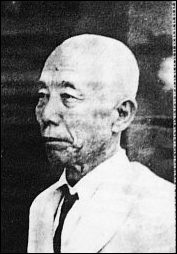 Tanaka in later life
Tanaka in later life A possible reconstruction of Tanaka's extended journey to Siam<
A possible reconstruction of Tanaka's extended journey to Siam<